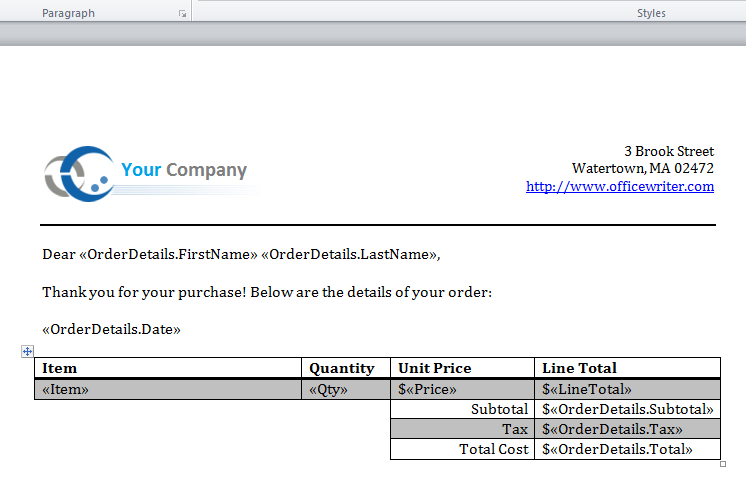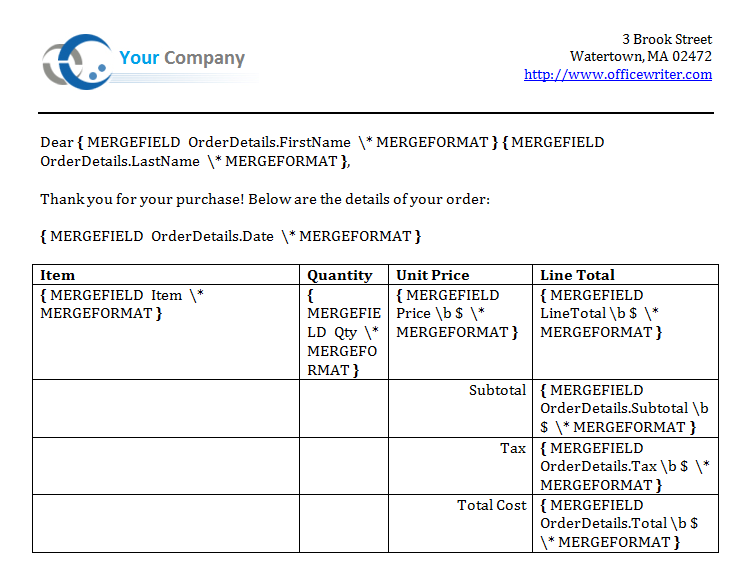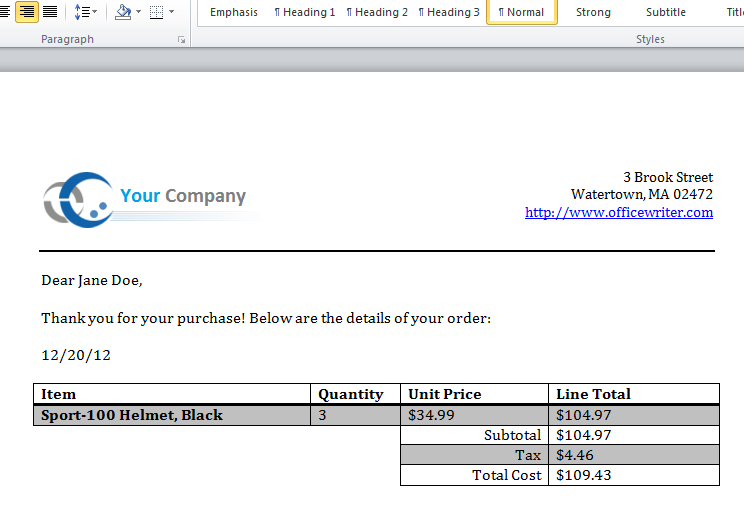Table of Contents |
|---|
Getting Started
About templates and merge fields
A WordWriter template is a Microsoft Word file that contains merge fields. A merge field displays a data source field (for example, a database column name). A merge field is created in Microsoft Word and bound in code to a data source. The data source may be an array, a DataSet, a DataTable, or a DataReader. When you run the code, WordWriter populates the merge fields with data source values. A template may contain multiple sets of merge fields. Each set of fields binds to a single data source.
Merge field syntax
- The general syntax is: DataSource.ColumnName
- Ordinal syntax (i.e. #1.#2 for source one, column two) can also be used
- Data source and column names must not include Unicode characters.
- Data source and column names must begin with a letter (A-Z, a-z).
- Data source and column names may include the following characters only:
ABCDEFGHIJKLMNOPQRSTUVWXYZabcdefghijklmnopqrstuvwxyz1234567890_ - Spaces are not allowed anywhere in a merge field.
Setting up the Template
Adding merge fields
The final template will resemble this:

1. Start with a blank .docx file.
2. Add the merge fields for the header and total data. These values are a single row of data called "OrderDetails" The values are "FirstName," "LastName," "Date," "SubTotal," "Tax," and "Total."
3. Create a table for the order data and add the merge fields. These values are in a data table created from AdventureWorks data. In this sample, the values are "Item," "Qty," "Price," and "LineTotal."
The template should resemble this: 
4. The template can be styled as desired. Any formatting applied to a merge field will be persisted when WordWriter populates the data.
Adding a WordWriter Reference in Visual Studio
Create a .NET project and add a reference to the WordWriter library.
- Open Visual Studio and create a .NET project.
- The sample code uses a web application.
- Add a reference to SoftArtisans.OfficeWriter.WordWriter.dll
- SoftArtisans.OfficeWriter.WordWriter.dll is located under Program Files > SoftArtisans > OfficeWriter > dotnet > bin
Writing the Code
1. Include the SoftArtisans.OfficeWriter.WordWriter namespace in the code behind
2. In the method that will actually run the report, instantiate the WordTemplate object.
3. Open the template file with the WordTemplate.Open method.
4. Create an object array for the header values and a string array for the column names.
WordTemplate can be bound to numerous types of .NET data structures: single variables, arrays (1-D, jagged, multi-dimensional), DataSet,DataTable, IDataReader etc. The source of the data can come from anywhere.
Some of the aforementioned structures have built in column names, such as the DataTable. When working with arrays, which don't have built in column names, you have to define the column names in a separate string array.
5. Get the data for the Order Info data set.
This call is to a helper method GetCSVData that parses the CSV files and returns a DataTable with the values.
If you are following in your own project and would like to parse the CSV files as well, you will need to:
- Add a reference to
GenericParsing.dll - Include
GeneringParsingat the top of your code. - Add the
GetCSVDatamethod that can be found in the sample code.
6. Use the WordTemplate.SetDataSource method to bind the order info to the merge fields in the template file. This data source has no name. One data source can be bound without a name, but it must be bound first.
SetDataSource() binds a single row of data to the template.
7. Use SetDataSource() to bind the order details arrays. Note that the data source name is the last string
8. Call WordTemplate.Process to import the data into the file.
9. Call WordTemplate.Save to save the output file.
WordTemplate has several output options: save to disk, save to a stream, stream the output file in a page's Response inline or as an attachment.
The final output should resemble this: 
Final Code
Downloads
You can download the code for the Basic WordWriter Tutorials as a Visual Studio solution, which includes the Simple Expense Summary.
- TODO: Add Link
